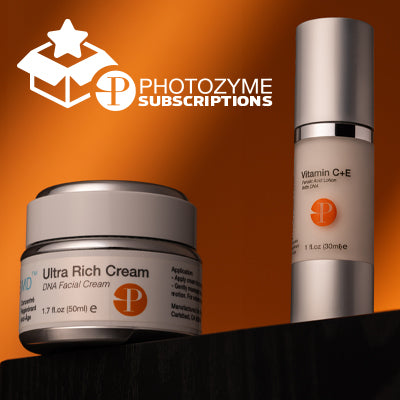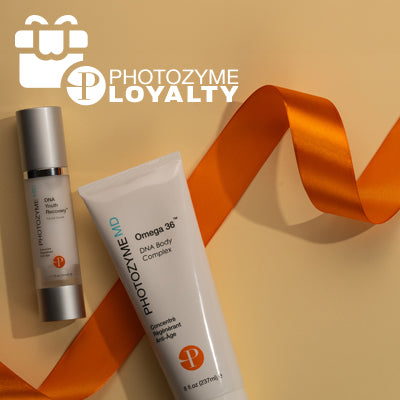
Key Takeaways:
- Reversing Sun Damage with DNA Repair Technology: Advancements in DNA repair technology offer significant promise in reversing sun damage, addressing the root causes at a cellular level.
- Daily Sunscreen and Nourishing Skincare: Preventive measures, including daily sunscreen use and a nourishing skincare routine, protect and heal sun-damaged skin.
- Innovative Treatments for Long-Term Skin Health: Incorporating innovative treatments, such as Photozyme MD's DNA Youth Recovery Facial Serum, can effectively reduce visible signs of sun damage and support long-term skin health.
As a leader in the skincare rejuvenation market, Photozyme MD provides a beacon of optimism for those seeking to combat and repair the outcomes of sun exposure. Grounded in the science of DNA repair technology, our products are meticulously designed to target the signs of sun damage and foster a revitalized, youthful complexion. Understanding the battle against sun damage is rigorous, and with Photozyme MD, we offer support backed by a foundational commitment to skin health and rejuvenation.
Exposure to the sun’s ultraviolet (UV) rays is a double-edged sword. While it can provide essential vitamin D and a golden tan, it also contributes to photoaging, resulting in premature wrinkles, sunspots, and a loss of skin elasticity. The damage caused by prolonged and unprotected sun exposure goes beyond superficial changes—it can alter the DNA of your skin cells, leading to long-term health issues and accelerated aging.
In this article, we will explore how the right approach and technological advancements can alleviate and even rectify some of the sun damage.
Understanding Sun Damage And Its Effects
Sun damage to the skin, also known as photoaging, often manifests as changes that can mar the aesthetic quality and health of your skin. Primarily caused by prolonged exposure to sun ultraviolet (UV) radiation, this damage affects the DNA in skin cells, leading to a cascade of adverse effects.
At a cellular level, the UV radiation from sunlight can cause direct DNA damage and oxidative stress, generating free radicals that can further harm cellular structures. When the DNA within skin cells is compromised, it can disrupt normal cell function and accelerate aging.
The most noticeable outcomes of this damage include:
- Wrinkles and fine lines: As sun damage breaks down collagen and elastin, the skin loses its elasticity, forming wrinkles and fine lines.
- Uneven pigmentation: Sun exposure can cause hyperpigmentation, such as age spots or sun spots, and overall uneven skin tone due to increased melanin production.
- Texture changes: Affected skin may become rough, leathery, or slack, losing its smooth and firm texture.
- Increased risk of skin cancer: The alteration of the skin's DNA significantly raises the risk of developing skin cancers, including melanoma, basal cell carcinoma, and squamous cell carcinoma.
The Science Behind Skin Repair
Our skin consists of various types of cells, including keratinocytes and melanocytes, which can be significantly affected by sun exposure. When UV rays penetrate the skin, they can create photoproducts that damage the DNA within these cells. This damage spurs the visible and invisible signs of aging, such as wrinkles, fine lines, and uneven pigmentation.
However, the body possesses mechanisms to repair some of this damage. One of the key components in the skin's repair system is a group of enzymes known as DNA repair enzymes. These enzymes travel along the DNA strands, identify errors caused by UV exposure, and initiate the repair process. This is where groundbreaking technology in skincare, such as Photozyme MD's DNA Youth Recovery Facial Serum, plays a pivotal role.
Our serum contains a powerful blend of these DNA repair enzymes that assist the skin's natural healing process. By directly applying these enzymes onto the skin, you help your body to accelerate its own reparative functions. This targeted approach encourages the removal of DNA damage caused by UV radiation, thus preventing the formation of mutations that can lead to signs of aging.
The Role Of Sunscreen In Preventing Further Harm
The use of broad-spectrum sunscreen, which protects against both UVA and UVB rays, is essential for guarding the sensitive layers of the skin. UVA rays are primarily responsible for skin aging, leading to wrinkles and sunspots. In contrast, UVB rays contribute to sunburns and are a major factor in developing skin cancers. Applying sunscreen with an SPF of 30 or higher can significantly reduce the risk of these adverse effects, whereas higher SPF values offer more protection.
Moreover, sunscreen plays a critical role in the efficacy of sun damage-reversal routines. By mitigating additional UV exposure, sunscreen allows the skin the opportunity to heal and permits restorative products, like those containing DNA repair enzymes, to perform optimally.
Innovations In Dermatology For Sun Damage
As the dermatology field progresses, significant advances have been made in treatments for reversing sun damage to the skin. These innovations focus on a range of strategies, from removing the damaged layers of skin to actually repairing the DNA within skin cells.
DNA Repair Enzymes
One of the most promising developments in the fight against sun damage is the emphasis on DNA repair technologies. Photozyme MD has been at the forefront of this advancement with its pioneering use of DNA repair enzymes in skincare. These enzymes are naturally occurring proteins that can recognize and repair the DNA damage caused by UV exposure. By applying these directly to the skin, Photozyme MD's products are designed to address sun damage at its source, effectively aiding in reversing some signs of photoaging and promoting healthy cell growth.
Laser Therapy
Another innovative approach involves the use of non-ablative and ablative laser therapies. These therapies work by stimulating collagen production and promoting skin renewal. These laser treatments can help reduce signs of sun damage, such as age spots and wrinkles.
Chemical Peels
Chemical peels have also evolved, with new, gentler formulations that can help improve the appearance of sun-damaged skin with less downtime. These peels work by removing the outermost layers of skin, thereby encouraging the growth of new, healthier skin cells.
Topical Antioxidants
Topical antioxidants, like vitamins C and E, effectively counter oxidative stress caused by sun exposure. Innovative skincare products combine these powerful antioxidants with sunscreens to provide additional protection against future sun damage.
Topical Treatments For Sun-Damaged Skin
Topical treatments are pivotal in this recovery process and can offer tangible results. Here are some of the most effective topical treatments for rejuvenating sun-damaged skin.
Retinoids
Retinoids such as retinol or prescription-level tretinoin are vital for accelerating cell turnover. By promoting the shedding of damaged cells and stimulating the growth of new, healthy cells, retinoids can reduce the appearance of fine lines, wrinkles, and uneven skin tone caused by sun exposure.
Antioxidants
Antioxidants are powerhouse ingredients that fight against free radicals, which cause oxidative stress and further damage skin cells. Topical antioxidants like vitamin C, E, and ferulic acid protect the skin from future damage and help repair it by brightening hyperpigmentation and promoting collagen production.
Alpha Hydroxy Acids (AHAs)
AHAs, such as glycolic and lactic acids, are chemical exfoliants that help remove the outermost layer of dead skin cells, revealing smoother, more even-toned skin beneath. Consistent use of AHAs can improve skin texture and diminish the signs of sun damage.
DNA Repair Enzymes
One of the most innovative avenues in treating sun-damaged skin is the application of DNA repair enzymes. These naturally occurring enzymes help to correct the DNA damage in skin cells caused by UV exposure. Our Photozyme MD products harness the power of these enzymes, offering a sophisticated solution to mitigate sun damage. For instance, the DNA Youth Recovery Facial Serum has been formulated to incorporate DNA repair enzymes that specifically target UV-related skin damage, thereby minimizing the effects of photoaging.
Final Thoughts
While the effects of sun damage on your skin can be distressing, advancements in skincare technology offer a beacon of hope. With the right approaches—including protective measures, reparative skincare routines, and innovative products like those offered by Photozyme MD—you can work to reverse the signs of sun damage significantly.
By harnessing the power of DNA repair enzymes, Photozyme MD's products, such as the DNA Youth Recovery Facial Serum, are at the forefront of tackling the consequences of UV exposure on the skin, helping to diminish the appearance of fine lines, wrinkles, and sunspots.
It's never too late to begin the journey toward rejuvenating your skin and protecting it from future damage. Embrace the Photozyme MD philosophy and take a proactive step towards healthier, more radiant skin. Adhering to the knowledge that with the right care and products, you can indeed help turn back the hands of time on sun-damaged skin.
Read Also:
- 6 Sunscreen Alternatives You Should Consider
- DNA Repair Enzymes: What Are They and How Do They Help Your Skin?
- What is The Best Vitamin C For Your Skin
Frequently Asked Questions About Can You Reverse Sun Damage
Is it possible to completely reverse sun damage?
While it is not always possible to completely reverse all signs of sun damage, many treatments and skincare regimens can significantly improve the appearance of sun-damaged skin.
What treatments can reverse sun damage?
Various treatments are available to help reverse sun damage, including topical applications with DNA repair enzymes, prescription medications, chemical peels, microdermabrasion, laser therapy, and photodynamic therapy. Consulting a dermatologist is the best way to determine which treatment suits your skin type and degree of sun damage.
Can sunscreen prevent further skin damage?
Regularly using a broad-spectrum sunscreen with an SPF of 30 or higher can help prevent further skin damage. Sunscreen acts as a protective barrier against harmful UV rays, significantly reducing the risk of premature aging and skin cancer.
How effective are over-the-counter products for sun damage?
Over-the-counter products can vary widely in their effectiveness. Products containing ingredients like DNA repair enzymes, retinol, vitamin C, and alpha hydroxy acids may help reduce the appearance of sun damage.
How long does it take to see improvement from sun damage?
Some may observe changes within a few weeks, while others may not notice significant improvement for several months. Consistent use of protective measures and adherence to skincare regimens are key to achieving the best results.
Can laser treatments remove sun spots?
Laser treatments can effectively remove or reduce the appearance of sunspots. These treatments target melanin, the pigment causing the sun spots, and can be highly effective after a few sessions. However, results can vary based on the type of laser used and individual skin responses.
Will chemical peels help with sun-damaged skin?
Chemical peels, which involve applying a solution to the skin to remove the top layers, can help with sun-damaged skin by revealing newer, less damaged skin beneath. The peel's effectiveness will depend on its depth, ranging from superficial to deep, with more dramatic results often seen with deeper peels.
What is photodynamic therapy for sun damage?
Photodynamic therapy (PDT) combines light-based therapy with a photosensitizing drug to target damaged skin cells. It is particularly useful for actinic keratosis, a precancerous condition caused by sun exposure. PDT can also improve overall skin texture and reduce the appearance of fine lines and wrinkles.
How does retinol help with sun damage?
Retinol, a vitamin A derivative, can help with sun damage by increasing cell turnover and stimulating collagen production. This can improve skin texture and even skin tone and reduce the appearance of fine lines and wrinkles. However, it's important to use retinol products as directed, as they can make the skin more sensitive to sunlight.




